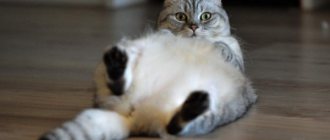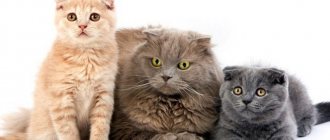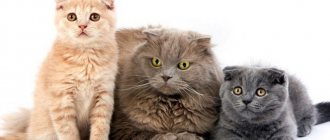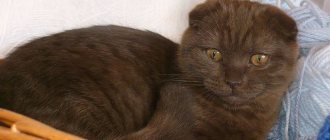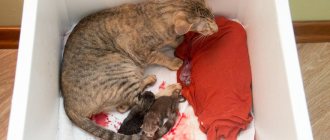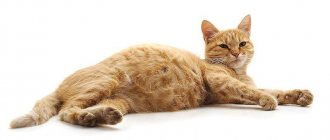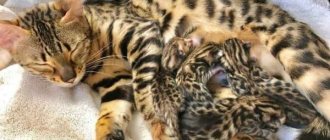Scottish cats are ideal mustachioed friends for any person. They have many undeniable qualities: cleanliness, calm disposition, unobtrusiveness, the ability to exist peacefully with other pets. Scottish cats are especially good-natured, which is why female cats so often start families. Scottish boys, as a rule, have a more independent character and prefer to keep the owner and other family members at a distance.
At first, when the Scottish girl is very small, the owner does not have any special problems. It is important to choose the right diet, take care of timely vaccination against severe infectious diseases, and the general health of the pet. But already from adolescence, when the animal is 8 months old, the owner will have to face a choice: whether to allow the pet to give birth to kittens or to deprive her of motherhood. If you still plan to mate a cat with a male, then the owner will certainly be faced with questions about the pregnancy of his pet. At what age can a pet be allowed to breed? How long does pregnancy last in Scottish cats, what are the symptoms of an “interesting” situation? How to behave correctly if there is a cat in the house expecting offspring? We will be looking for answers to these questions.
At what age can you knit tartan?
The first heat in Scottish cats, like in other cats, should be expected at 8 months. However, the body has not yet finished growing, and early pregnancy can undermine the health of the pet. And the offspring of a precocious mother will not be in good health.
Scots are considered large pets, so they are ready for the first mating later than cats of smaller breeds. The optimal age for the first pregnancy is one and a half years.
A partner for the Scottish female should be looked for several months before the intended mating, preferably not far from home, in order to have time to connect the couple on the 2nd or 3rd day of estrus.
Knitting features
The Scottish Fold cat reaches sexual maturity at 8 months. The pet becomes extremely active, screams loudly and demands the cat. Breeders do not recommend mating at an early age. The body of a Scottish Fold cat is not yet ready for childbirth, even after puberty. Mating is best done after one year and at least after 4-5 heats.
It is worth paying attention to a potential partner. A Scottish Fold cat should only be mated with a straight-eared male. This is an unshakable rule that cannot be broken. Otherwise, when two fold-eared cats are mated, the offspring are born incompetent and soon die.
This is due to the lop ear gene, which greatly affects the musculoskeletal system. Simply put, this is a hereditary disease that manifests itself in the first offspring.
ATTENTION! Before the first mating, it is mandatory to conduct an examination at a veterinarian or in a clinic. The specialist will conduct an examination and, if necessary, prescribe treatment, especially if the cat is purebred. Before pregnancy, a Scottish cat must be completely healthy so that there are no complications during the birth process.
Mating a Scottish cat is a responsible occupation. Particular attention should be paid to the health of the future partner and his pedigree.
Signs of pregnancy in Scottish cats
After mating, the cat calms down and becomes imposing. If the pet does not have contact with other animals at this time and eats according to its needs, the onset of pregnancy proceeds without problems. The first signs of pregnancy are observed 2-3 weeks after conception. The cat, as well as the woman, experiences attacks of morning sickness, characteristic of toxicosis of pregnancy.
The pet's nipples begin to turn pink, and the hair around them gradually falls out. However, such changes are individual and ultrasound is a reliable test for pregnancy. The first examination is usually carried out 3 weeks after mating.
Be sure to read:
Can a cat give birth to one kitten if the fetus is in the birth canal, what to do?
Even an inexperienced owner can determine that a cat is pregnant in the sixth week of gestation. By this time, her belly is rounded, her nipples swell, and her mammary glands enlarge.
If the fruits are dead...
Sometimes a phenomenon called fetal resorption in a cat can occur, in which resorption (resorption) of the fetus occurs in the uterus. This undesirable effect occurs under various unfavorable conditions: the cat’s health condition and external factors. If the fetus dies in the early stages, while the skeletal system is not formed, this most often passes without negative consequences for the cat’s health. If resorption occurs in the later stages, then such phenomena as mummification (drying), maceration (softening of tissues), petrification (deposition of lime) and putrefaction (putrefactive decomposition) are observed. Such conditions can be life-threatening for the cat and require veterinary intervention.
Behavior of a pregnant fold cat
A pregnant cat changes its behavior. Hormonal surges change behavior. The cat alternately pets and looks irritated. Fetal development increases food requirements during the fourth week of pregnancy. At that time, the feed portion can be increased by 10-15%. In subsequent weeks, the animal is no longer restricted in food, but in order to avoid overeating, it is fed in small portions, but often.
The best option is to switch to ad libitum feeding with dry granules. The fifth week of pregnancy has only just begun, and the Scotswoman is already beginning to nest: she is looking for a secluded place. If the owners are planning to purchase a cat house, then this time is most suitable for the implementation of the intention.
During the seventh week, the cat may lose its appetite for a while. The embryos begin to grow fur and the cat hibernates at this time. The body is rebuilt, some of the nutrients are redirected into the formation of fruits to prepare the mammary glands for lactation. This process requires calmness, so the cat becomes drowsy.
In the last weeks before lambing, the Scotch cow becomes active again, once again walking around the property in search of a more convenient nest. It's time to satisfy your curiosity and repeat the ultrasound. You can determine the number of fruits and observe their movements. However, someone may be undetected and the actual number of kittens turns out to be greater than expected.
Duration
Having decided on the timing of pregnancy in the Scottish Fold, let’s pay attention to the factors that influence the duration of gestation of kittens:
- Animal weight. The weight of a cat directly depends on the timing of gestation. Overweight tartan women stay pregnant longer than their thin counterparts.
- Age. In the early stages, when pregnancy occurs before one year, premature birth may occur. This will lead to the death of the offspring. Usually the first pregnancy at such an early age occurs at 45-50 days.
- Health conditions. A weak and sickly animal is unable to bear healthy kittens. Hereditary diseases, parasites, even a simple runny nose will lead to premature birth or unhealthy offspring.
- Number of kittens. A cat is capable of giving birth to up to 10(!) kittens at a time. The average litter is 4-5 kittens. The length of pregnancy depends on the number of kittens. The more babies in the womb, the sooner they will be born.
This is interesting: What diseases do Scottish Fold cats have?
What to feed a pregnant Scottish Fold cat
No special food has been developed for pregnant and lactating cats. Manufacturers of ready-made food believe that the nutritional needs of a mother cat are the same as those of kittens. Therefore, it is recommended to switch a pregnant pet to baby food from the moment pregnancy is considered established.
Be sure to read:
Pregnant Sphynx cat: how to find out about the position, changes in behavior and appearance, how long they walk
That is, if on the 25th day after mating an ultrasound showed the presence of embryos, the pet begins to gradually replace the previous food with a new one. This should be done gradually over a week to prevent feeding stress, which will negatively affect the fruit.
If an ultrasound was not performed for some reason, the transition to a new food begins when pregnancy is established based on other signs.
Malyshovsky food is as close as possible to milk in terms of energy and protein concentration, therefore it contains a lot of fat. For this reason, it should not be given immediately after mating, since Scottish females are prone to obesity.
The best option is universal holistic food such as Acana or Orijen, or specialized food Royal Canin Mother & Babycat. Adherents of natural food should create a diet that is not inferior in nutritional value to the indicated ready-made food.
Stages
Let's pay attention to a brief description of the animal's condition at different weeks of pregnancy:
- 1 Week. The pregnancy of a Scottish Fold cat is almost impossible to notice. The nipples swell slightly and their color changes, but even experienced breeders find this difficult to notice.
- In the womb of the expectant mother, fetuses are already being formed, their number and the sex of the babies have been determined. Cell division after fertilization occurs after 60 hours. Division continues every 12-14 hours. Around day 4, small clusters of cells form, from which the future baby will form.
- Week 2. Using an ultrasound machine, the doctor can already determine whether the cat is pregnant or not. Experienced breeders can feel the fruits with their fingers, but this should be done extremely carefully so as not to harm future kittens.
- Palpation is strictly not recommended for novice owners! The fetuses in the womb are still small, but are actively developing.
- Week 3. It is during the third week that cats begin to experience morning vomiting. It usually lasts no more than a week. This stage of pregnancy is interesting because the Scottish cat exhibits an interesting feature - superfetation. This is the repeated mating of a cat with a cat, perhaps not even the father of the future kittens.
- Superfetation is extremely rare in humans, but it is quite possible in every tenth cat. But in order to mate again, you need to be in heat, the inquisitive reader will tell you. Right! But it can be triggered by many factors.
- 4 and 5 weeks. At this stage of pregnancy, the cat's behavior changes dramatically. In addition, at 4-5 weeks there is a high chance of miscarriage, so it is extremely important that the Scottish Fold cat approaches pregnancy absolutely healthy.
- Babies develop bones, although they are still made of cartilage. Muscles, teeth and genitals develop. The babies can hear their heartbeat. By the end of the 5th week, the fetuses completely occupy the uterus. The skeleton is strengthened, most of the internal organs are formed.
- 6 and 7 weeks. By this time, the cat becomes noticeably fatter and activity subsides. But a pet can fall from a height and damage its offspring. The pregnant mother should be especially closely monitored.
- It is difficult for a cat to take care of personal hygiene; its stomach prevents it from licking its fur and organs. After visiting the toilet, the owner should take a cotton pad and wipe the pet. The cat begins to eat less, preparing itself for childbirth. Kittens develop fur in the womb, they have grown significantly and are actively moving in the stomach.
- Weeks 8 and 9. The cat is actively preparing for childbirth. He sleeps a lot and is not active, sometimes trying to find a secluded place to give birth. It is not difficult to prepare a “maternity ward” in an apartment in advance, but this should be taken care of in the first weeks of pregnancy.
Including private presence next to the cat. There have been cases when the residual, but strong and constant smell of a male, which came from the clothes of the owners, provoked estrus in a Scottish cat.
If this happens, there are several possible scenarios:
- the offspring will die completely;
- babies born after the second conception will not survive;
- the cat will give birth to both litters, but they will be weak and will require additional strength to deliver them. A cat cannot do this alone. The embryos develop a body, head and internal organs. You can even see a small tail!
Color-point kittens are monochromatic in the womb. The color depends on the temperature of the area of the body where the fur grows. Inside the cat's mother, the temperature is uniform, but after giving birth, the color of the kitten's fur changes. He independently regulates his body heat. If the gestation period has exceeded 70 days, the owner should contact a veterinarian.
How to help a Scottish woman during childbirth
The first aid before lambing is preparing the den. The simplest option is a cardboard box with holes cut for ventilation, lined with paper and covered with a soft cloth. The future house for kittens is placed in a secluded place. The nesting cat is picked up and placed in a prepared place. If the cat shows willfulness and lambs in another place. She, along with her offspring, is placed in a prepared den, from which she will never leave.
It is good if a veterinarian is present during the birth, but most owners can provide assistance on their own. Most often, the cat copes on its own.
Be sure to read:
A pregnant cat has bleeding: normal or pathological, what to do when you need help
Labor begins with the release of amniotic fluid. The kitten is born in the amniotic sac, which bursts and the cat gnaws the umbilical cord. If she did not do this, you need to cut the cord with sterile scissors and treat the stump with tincture of iodine. The mother usually eats the placenta. This is normal, but you should not allow more than two placentas to be eaten. When the cat has the intention of eating another afterbirth, food is added to it.
If the bubble does not open on its own, it is broken with your fingers. The kitten is shaken, the liquid is removed from the mouth with a baby syringe and placed on the mother.
The normal interval between the births of kittens is considered to be a quarter of an hour. All afterbirths come out within half a day after the birth of the last kitten. If labor is difficult, call a veterinarian.
Circumstances on which the duration of gestation depends
The duration of pregnancy in cats of long-haired breeds, as a rule, is longer (from 58 to 72 days) than in short-haired and hairless cats (58-68 days).
How long a pet can walk while pregnant also depends on the number of cubs in her womb. When there are few of them, the duration will be longer, and when the number of babies exceeds five, the birth will be delivered a little earlier.
It is considered normal when the period is delayed by one week, and the mother and babies feel good. When resolution of the burden does not occur for a longer time, you should consult a specialist. In such a situation, the owner needs to be aware of exactly when fertilization occurred (it takes place approximately a day or a day and a half after the cat mates with the male).
We invite you to read: Ketosteril for cats: instructions for use, indications and side effects
When contractions begin 7 days ahead of schedule, then, unfortunately, the babies may not survive. Even if their number reaches 12, this period is too early for a successful outcome.
The duration of pregnancy can also be affected by the emotional state at the end of the term. A negative attitude delays childbirth.
The female’s belonging to a certain breed also affects the duration. For example, Siamese cats stay pregnant longer than other cats. See how many months a cat goes pregnant.
Nutrition
In the first weeks of pregnancy, the Scottish cat eats as usual. But in the later stages, the pet gradually refuses frequent meals because... kittens grow and take up all the space in the stomach. In this case, you should reduce the diet, but give portions more often 4-5 times a day.
For a pregnant cat, not just a proper diet is important, but also one rich in minerals and vitamins . It would be a good idea to add special vitamin complexes to the bowl, which can be purchased at the pharmacy.
If your cat's diet consists of dry food, it is recommended to gradually add canned food for kittens to the bowl. By the end of pregnancy, the menu should preferably consist of canned food. When eating natural foods, experts recommend including the following foods in your diet:
- boiled meat (about half of the diet);
- boiled vegetables;
- eggs;
- small portions of lean boiled fish (in no case sea fish!)
To improve the functioning of the digestive system, it is recommended to add beet puree to the diet.
To actively produce milk, you can feed your cat a salad of scalded nettle leaves. To facilitate childbirth and prevention, you can give a decoction of raspberry leaves. Twice a day - morning and evening.
What owners should do and what not to do to preserve the gestation period of their offspring
In order for the cat to emerge within the prescribed period, the owners need to know several rules about what should be done and what should be avoided during this period, so that the duration does not change towards critical. Rules are not a panacea, because There is also a genetic predisposition, which “you can’t argue with.
What do we have to do:
- Contact a specialist as soon as possible after the expected conception to identify possible risks to the life and health of the fetus and for the mother cat. It is wise to use an ultrasound to find out if the cat is pregnant at all.
- Contact your veterinarian if Murka exhibits any strange behavior or changes in health (vomiting, fever, lack of appetite).
- Protect the pet from children so that they do not squeeze, kick or make any sudden movements towards the animal.
- Provide balanced and sufficient nutrition.
- If necessary, give vitamins for pregnant women (veterinary).
What not to do:
- Make Murka nervous. This includes purchasing new pets during this period, arranging noisy events indoors where the cat cannot hide, and allowing children in.
- Press the stomach tightly, supposedly trying to determine how many babies should be born. It is almost impossible to do this with your hands, especially for a non-specialist, and it is easy to injure the abdomen!
- Give any medications without consulting a veterinarian.
- Allow Murka to jump from a height or climb there.
- Washing or treating your home with strong and strong-smelling household chemical solutions is a direct path to poisoning.
- Allow contact with sick and abandoned animals.
- Do not follow the rules of hygiene (stroking with dirty hands after going outside or allowing you to sleep in the shoes you came in from the street in).
General information about the duration of gestation
On average, the question “how long does a cat stay pregnant?” The most frequently heard answer is 2 months. However, this is a rather loose concept - some individuals barely carry their offspring to term for up to 60 days, and for some the process can last up to 70. According to general estimates, the minimum gestation period for cats is from 56 to 60 days, the maximum normal is considered to be 71 days (some sources give 72 days). These are periods when the birth of viable offspring is allowed. Most often - 64-67 days (roughly rounded, it comes out to 9 weeks).
The entire “pregnant” period is conventionally divided into 3 phases of development, each of which on average includes 3 weeks.
1 phase
This period lasts from the moment of expected conception to 21 days. During this period, eggs are fertilized and embryos develop. By the 15th day, the embryo already becomes up to 1 cm in size, by the 18th day the paws appear, and by the end of the period the internal organs are already formed. It is in this phase that active pinking of the nipples is observed.
2 phase
During this period (from 22 to 42 days), the brain, skeletal structure, muscles and endocrine system are actively formed and developed. From this point on, the kittens are called fetuses, taking on the classic feline appearance with a clearly defined muzzle and genitals. Only after a month of pregnancy the cat’s belly begins to grow a little.
3 phase
On days 43-63 from the moment of conception, kittens, growing to 8-10 cm, acquire a tail and acquire a coat with a certain color. By the middle of the period, their size reaches 13 cm, by the 57th day they are already fully formed and developed babies who are ready to be born at any moment.
There are exceptions to all rules. The duration may vary depending on many factors:
- offspring of purebred individuals born before 60 days are most often non-viable;
- cats with a slender constitution (subtle) usually never go pregnant longer than 65 days (on average it is 60-65 days), and fat and well-fed ones usually carry a pregnancy and the period can reach 70-72 days;
- primiparous cats, especially those who become pregnant during their first heat before the age of 1 year, in most cases give birth earlier than the expected average period (up to 60 days). Kittens are not always born viable and are often weak and small. That is why experienced breeders do not recommend mating a cat to produce offspring in the first heat and under the age of one year;
- primiparous middle-aged cats bear their offspring somewhat longer than their female peers who have given birth;
- yard outbred cats bear less fruit than domestic and special breed cats. Sometimes healthy babies are born on the 55th day - this indicates better endurance and higher adaptability of street individuals compared to domestic ones;
- in a fold cat (British, Scottish), kittens are gestated for an average of 63-67 days, but almost never less than 60 days;
- cases of nursing up to 75 days have been recorded. The course of the entire period was without complications, and the newborns were all alive and well. The reasons for such a long but safe gestation are still a mystery to veterinarians;
- Pregnancy of the Maine Coon breed is usually longer than that of other breeds - up to 68 days or 9 full weeks in preparation for the birth of the cat herself;
- long-haired cats stay pregnant longer (up to 70 days) than smooth-haired or completely hairless cats (around 65 days);
- the fewer fruits there are in the litter, the longer the cat can go pregnant and, conversely, the more, the faster and more often the birth will occur before the due date;
- weather conditions affect the onset of labor - sudden changes in temperature and environmental humidity can suddenly trigger premature birth;
- The pregnancy of a Scottish cat is usually shorter than that of a British cat, in which the pregnancy period can sometimes increase to 70-72 days. Therefore, there is no clear answer to the questions of how long pregnancy lasts in a Scottish cat or how long pregnancy lasts in a British cat - variations in duration are present here too.
( 2 ratings, average 4.5 out of 5 )

